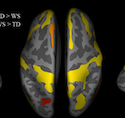Abstract
Morphometric investigations of brain volumes in Williams syndrome (WS) consistently show significant reductions in gray matter volume compared to controls. Cortical thickness (CT) and surface area (SA) are two constituent parts of cortical gray matter volume that are considered genetically distinguishable features of brain morphology. Yet, little is known about the independent contribution of cortical CT and SA to these volumetric differences in WS. Thus, our objectives were: (i) to evaluate whether the microdeletion in chromosome 7 associated with WS has a distinct effect on CT and SA, and (ii) to evaluate age‐related variations in CT and SA within WS. We compared CT and SA values in 44 individuals with WS to 49 age‐ and sex‐matched typically developing controls. Between‐group differences in CT and SA were evaluated across two age groups: young (age range 6.6–18.9 years), and adults (age range 20.2–51.5 years). Overall, we found contrasting effects of WS on cortical thickness (increases) and surface area (decreases). With respect to brain topography, the between‐group pattern of CT differences showed a scattered pattern while the between‐group surface area pattern was widely distributed throughout the brain. In the adult subgroup, we observed a cluster of increases in cortical thickness in WS across the brain that was not observed in the young subgroup. Our findings suggest that extensive early reductions in surface area are the driving force for the overall reduction in brain volume in WS. The age‐related cortical thickness findings might reflect delayed or even arrested development of specific brain regions in WS. © 2016 Wiley Periodicals, Inc.
